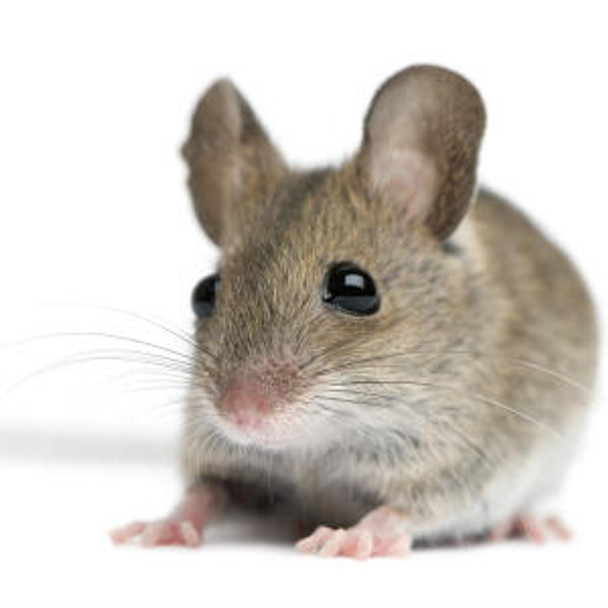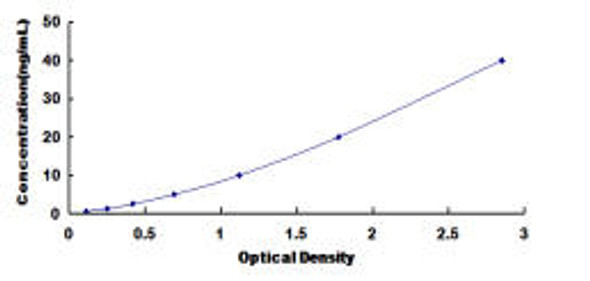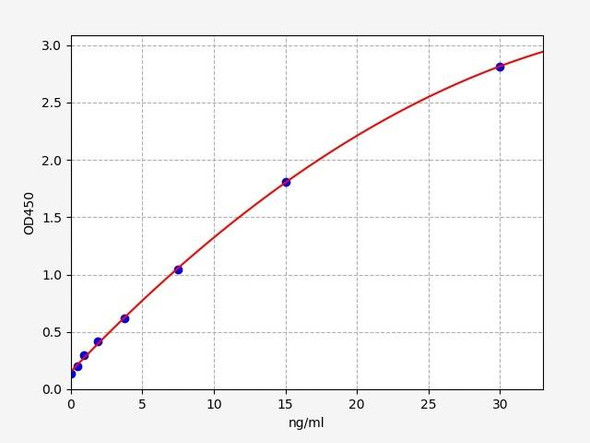Mouse Complement C4-B (C4b) ELISA Kit (MOEB0904)
- SKU:
- MOEB0904
- Product Type:
- ELISA Kit
- Size:
- 96 Assays
- Uniprot:
- P01029
- ELISA Type:
- Sandwich
- Synonyms:
- C4
- Reactivity:
- Mouse
Description
Mouse Complement C4-B (C4b) ELISA Kit
The Mouse Complement C4-B (C4B) ELISA Kit is a highly sensitive and specific assay designed for the accurate detection of complement C4-B levels in mouse serum, plasma, and cell culture supernatants. This kit provides reliable and reproducible results, making it a valuable tool for research applications in the fields of immunology and inflammation.Complement C4-B is a key component of the complement system, playing a crucial role in immune responses and inflammatory processes.
Dysregulation of complement C4-B has been linked to various autoimmune diseases, infectious diseases, and inflammatory conditions, making it an important biomarker for studying these disorders and developing targeted therapies.With its high performance and ease of use, the Mouse Complement C4-B (C4B) ELISA Kit is an essential tool for researchers looking to investigate the role of complement C4-B in immune function and disease pathogenesis in mouse models.
| Product Name: | Mouse Complement C4-B (C4b) ELISA Kit |
| SKU: | MOEB0904 |
| Size: | 96T |
| Target: | Mouse Complement C4-B (C4b) |
| Synonyms: | C4 |
| Assay Type: | Sandwich |
| Detection Method: | ELISA |
| Reactivity: | Mouse |
| Detection Range: | 78-5000pg/mL |
| Sensitivity: | 39.24pg/mL |
| Intra CV: | 0.0% | ||||||||||||||||||||
| Inter CV: | 0.0% | ||||||||||||||||||||
| Linearity: |
| ||||||||||||||||||||
| Recovery: |
| ||||||||||||||||||||
| Function: | Non-enzymatic component of C3 and C5 convertases and thus essential for the propagation of the classical complement pathway. Covalently binds to immunoglobulins and immune complexes and enhances the solubilization of immune aggregates and the clearance of IC through CR1 on erythrocytes. Catalyzes the transacylation of the thioester carbonyl group to form ester bonds with carbohydrate antigens. |
| Uniprot: | P01029 |
| Sample Type: | Serum, plasma, tissue homogenates, cell culture supernates and other biological fluids |
| Specificity: | Natural and recombinant mouse Complement C4-B |
| Sub Unit: | Circulates in blood as a disulfide-linked trimer of an alpha, beta and gamma chain. |
| Subcellular Location: | Secreted Cell junction Synapse Cell projection Axon Cell projection Dendrite |
| Storage: | Please see kit components below for exact storage details |
| Note: | For research use only |
| UniProt Protein Function: | C4B: C4 plays a central role in the activation of the classical pathway of the complement system. It is processed by activated C1 which removes from the alpha chain the C4a anaphylatoxin. The remaining alpha chain fragment C4b is the major activation product and is an essential subunit of the C3 convertase (C4b2a) and the C5 convertase (C3bC4b2a) enzymes of the classical complement pathway. Defects in C4B are a cause of susceptibility to systemic lupus erythematosus (SLE). A chronic, inflammatory and often febrile multisystemic disorder of connective tissue. It affects principally the skin, joints, kidneys and serosal membranes. It is thought to represent a failure of the regulatory mechanisms of the autoimmune system. Interindividual copy- number variation (CNV) of complement component C4 and associated polymorphisms result in different susceptibilities to SLE. The risk of SLE susceptibility has been shown to be significantly increased among subjects with only two copies of total C4. A high copy number is a protective factor against SLE. Defects in C4B are the cause of complement component 4B deficiency (C4BD). A rare defect of the complement classical pathway associated with the development of autoimmune disorders, mainly systemic lupus with or without associated glomerulonephritis. |
| UniProt Protein Details: | Protein type:Secreted; Secreted, signal peptide Cellular Component: extracellular space; extracellular region Molecular Function:complement binding; complement component C1q binding; carbohydrate binding Biological Process: immunoglobulin mediated immune response; complement activation |
| UniProt Code: | P01029 |
| NCBI GenInfo Identifier: | 287732 |
| NCBI Gene ID: | 12268 |
| NCBI Accession: | CAA39114.1 |
| UniProt Secondary Accession: | P01029,O70346, Q31201, Q3TYY1, Q3TZC9, Q61372, Q61859 Q62353, Q6NWV8, E9QKK7, |
| UniProt Related Accession: | P01029 |
| Molecular Weight: | 192,915 Da |
| NCBI Full Name: | C4, partial |
| NCBI Synonym Full Names: | complement component 4B (Chido blood group) |
| NCBI Official Symbol: | C4b |
| NCBI Official Synonym Symbols: | C4; Ss |
| NCBI Protein Information: | complement C4-B; complement component 4 (within H-2S); complement component 4B (Childo blood group) |
| UniProt Protein Name: | Complement C4-B |
| Protein Family: | Complement C4 |
| UniProt Gene Name: | C4b |
| UniProt Entry Name: | CO4B_MOUSE |
| Component | Quantity (96 Assays) | Storage |
| ELISA Microplate (Dismountable) | 8×12 strips | -20°C |
| Lyophilized Standard | 2 | -20°C |
| Sample Diluent | 20ml | -20°C |
| Assay Diluent A | 10mL | -20°C |
| Assay Diluent B | 10mL | -20°C |
| Detection Reagent A | 120µL | -20°C |
| Detection Reagent B | 120µL | -20°C |
| Wash Buffer | 30mL | 4°C |
| Substrate | 10mL | 4°C |
| Stop Solution | 10mL | 4°C |
| Plate Sealer | 5 | - |
Other materials and equipment required:
- Microplate reader with 450 nm wavelength filter
- Multichannel Pipette, Pipette, microcentrifuge tubes and disposable pipette tips
- Incubator
- Deionized or distilled water
- Absorbent paper
- Buffer resevoir
*Note: The below protocol is a sample protocol. Protocols are specific to each batch/lot. For the correct instructions please follow the protocol included in your kit.
Allow all reagents to reach room temperature (Please do not dissolve the reagents at 37°C directly). All the reagents should be mixed thoroughly by gently swirling before pipetting. Avoid foaming. Keep appropriate numbers of strips for 1 experiment and remove extra strips from microtiter plate. Removed strips should be resealed and stored at -20°C until the kits expiry date. Prepare all reagents, working standards and samples as directed in the previous sections. Please predict the concentration before assaying. If values for these are not within the range of the standard curve, users must determine the optimal sample dilutions for their experiments. We recommend running all samples in duplicate.
| Step | |
| 1. | Add Sample: Add 100µL of Standard, Blank, or Sample per well. The blank well is added with Sample diluent. Solutions are added to the bottom of micro ELISA plate well, avoid inside wall touching and foaming as possible. Mix it gently. Cover the plate with sealer we provided. Incubate for 120 minutes at 37°C. |
| 2. | Remove the liquid from each well, don't wash. Add 100µL of Detection Reagent A working solution to each well. Cover with the Plate sealer. Gently tap the plate to ensure thorough mixing. Incubate for 1 hour at 37°C. Note: if Detection Reagent A appears cloudy warm to room temperature until solution is uniform. |
| 3. | Aspirate each well and wash, repeating the process three times. Wash by filling each well with Wash Buffer (approximately 400µL) (a squirt bottle, multi-channel pipette,manifold dispenser or automated washer are needed). Complete removal of liquid at each step is essential. After the last wash, completely remove remaining Wash Buffer by aspirating or decanting. Invert the plate and pat it against thick clean absorbent paper. |
| 4. | Add 100µL of Detection Reagent B working solution to each well. Cover with the Plate sealer. Incubate for 60 minutes at 37°C. |
| 5. | Repeat the wash process for five times as conducted in step 3. |
| 6. | Add 90µL of Substrate Solution to each well. Cover with a new Plate sealer and incubate for 10-20 minutes at 37°C. Protect the plate from light. The reaction time can be shortened or extended according to the actual color change, but this should not exceed more than 30 minutes. When apparent gradient appears in standard wells, user should terminatethe reaction. |
| 7. | Add 50µL of Stop Solution to each well. If color change does not appear uniform, gently tap the plate to ensure thorough mixing. |
| 8. | Determine the optical density (OD value) of each well at once, using a micro-plate reader set to 450 nm. User should open the micro-plate reader in advance, preheat the instrument, and set the testing parameters. |
| 9. | After experiment, store all reagents according to the specified storage temperature respectively until their expiry. |
When carrying out an ELISA assay it is important to prepare your samples in order to achieve the best possible results. Below we have a list of procedures for the preparation of samples for different sample types.
| Sample Type | Protocol |
| Serum | If using serum separator tubes, allow samples to clot for 30 minutes at room temperature. Centrifuge for 10 minutes at 1,000x g. Collect the serum fraction and assay promptly or aliquot and store the samples at -80°C. Avoid multiple freeze-thaw cycles. If serum separator tubes are not being used, allow samples to clot overnight at 2-8°C. Centrifuge for 10 minutes at 1,000x g. Remove serum and assay promptly or aliquot and store the samples at -80°C. Avoid multiple freeze-thaw cycles. |
| Plasma | Collect plasma using EDTA or heparin as an anticoagulant. Centrifuge samples at 4°C for 15 mins at 1000 × g within 30 mins of collection. Collect the plasma fraction and assay promptly or aliquot and store the samples at -80°C. Avoid multiple freeze-thaw cycles. Note: Over haemolysed samples are not suitable for use with this kit. |
| Urine & Cerebrospinal Fluid | Collect the urine (mid-stream) in a sterile container, centrifuge for 20 mins at 2000-3000 rpm. Remove supernatant and assay immediately. If any precipitation is detected, repeat the centrifugation step. A similar protocol can be used for cerebrospinal fluid. |
| Cell culture supernatant | Collect the cell culture media by pipette, followed by centrifugation at 4°C for 20 mins at 1500 rpm. Collect the clear supernatant and assay immediately. |
| Cell lysates | Solubilize cells in lysis buffer and allow to sit on ice for 30 minutes. Centrifuge tubes at 14,000 x g for 5 minutes to remove insoluble material. Aliquot the supernatant into a new tube and discard the remaining whole cell extract. Quantify total protein concentration using a total protein assay. Assay immediately or aliquot and store at ≤ -20 °C. |
| Tissue homogenates | The preparation of tissue homogenates will vary depending upon tissue type. Rinse tissue with 1X PBS to remove excess blood & homogenize in 20ml of 1X PBS (including protease inhibitors) and store overnight at ≤ -20°C. Two freeze-thaw cycles are required to break the cell membranes. To further disrupt the cell membranes you can sonicate the samples. Centrifuge homogenates for 5 mins at 5000xg. Remove the supernatant and assay immediately or aliquot and store at -20°C or -80°C. |
| Tissue lysates | Rinse tissue with PBS, cut into 1-2 mm pieces, and homogenize with a tissue homogenizer in PBS. Add an equal volume of RIPA buffer containing protease inhibitors and lyse tissues at room temperature for 30 minutes with gentle agitation. Centrifuge to remove debris. Quantify total protein concentration using a total protein assay. Assay immediately or aliquot and store at ≤ -20 °C. |
| Breast Milk | Collect milk samples and centrifuge at 10,000 x g for 60 min at 4°C. Aliquot the supernatant and assay. For long term use, store samples at -80°C. Minimize freeze/thaw cycles. |









